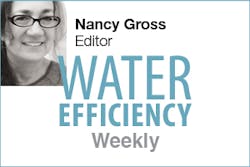The Las Vegas Review-Journal reported last week that Lake Mead is hitting a level it hasn’t been at since it was in the process of filling up behind the brand new Hoover Dam 78 years ago, in 1937. The Colorado River is not what it used to be. The article, by Henry Brean, discusses the effect on both drinking water delivery and recreation, and the costs involved in supporting both capacities while the drought in the Western states persists. Not only is a new deep-water intake pipe being built, but boat ramps are being extended to compensate for drying shorelines. Read “Savage drought will drive Lake Mead to record low on Sunday” here or copied as the last portion of this blog.
I will be in Las Vegas when this writing is released, attending a building commissioning show, CxEnergy. I intend to keep an eye and an ear out for how the glittering desert oasis is managing water. A year ago Slate Magazine reporter Eric Holthaus was not very inspired. His article “The Thirsty West: What Happens in Vegas Doesn’t Stay in Vegas” begins with the shock of seeing the Lake Mead “bathtub ring,” then talks about how the deep-water pipe, or tunnel, being built was called by officials “an emergency to avoid an emergency.” Holthaus also includes this examination:
The driest city in America still uses more water per capita than just about any other city in the country. This despite years of steady efficiency improvements and the resounding success of its “cash for grass” program that pays residents for each square foot of lawn they rip out and replace with rocks. Front lawns are now illegal in Las Vegas, yet verdant golf courses are still commonplace. About 70% of the city’s nearly maxed-out water diversion from Lake Mead still goes to landscaping.
Don’t get me wrong: The city has made major improvements in water efficiency, using about 40% less water per person over the past 25 years or so. The problem is the city’s population has tripled over that same time, and total water usage is up (though down from its peak about a decade ago—an improvement due at least partially to the economic downturn). It’s like a one-ton man patting himself on the back for losing 400 pounds. Great news, but there’s still a long way to go.
At CxEnergy, I will attend “The Art of Water Reuse and Optimization in a World of Diminishing Water Supply”, by Frank Ladd of Aquanomix. The talk is on reuse, a theme that fits into this discouraging landscape, offering a little bit of hope: “Water reuse decreases a facility’s utility operating expenses, serves as a redundant water supply for critical facilities, and reduces onsite stormwater in areas with moderate to heavy rainfall. This session will explore forward-looking approaches to water control management and monitoring, from capturing existing water sources (including rainwater, greywater, stormwater, and foundation water), through filtering and disinfection, followed by reuse for cooling tower makeup, toilet flushing, irrigation, or any other nonpotable use. Continuous water quality management and wateroptimization software will also be addressed.”
“Savage drought will drive Lake Mead to record low on Sunday” from the Las Vegas Review-Journal, by Henry Brean.
Sunday’s forecast for Lake Mead calls for breezy conditions, with a high in the low 80s and a water level as low as it has been in 78 years.
The reservoir east of Las Vegas is expected to reach a new record low this weekend and continue downward another 7 feet through June, as the drought-stricken Colorado River withers from its 12th dry year since 2000.
The latest projections by the U.S. Bureau of Reclamation call for the new record to arrive sometime after midnight Sunday, when the surface of Lake Mead dips below the current low-water mark, set on Aug. 13, 2014, of 1,080.19 feet above sea level.
The last time Lake Mead was this low was May 1937, the same month as the Hindenburg explosion. The reservoir then was filling for the first time behind the new Hoover Dam.
The bleak new milestone comes as federal forecasters slash their projections for how much water will make its way into the Colorado River in the coming months, as snow melts away in the mountains of Utah, Colorado and Wyoming.
Last month, the forecast called for the river that supplies water and power to some 40 million people in the U.S. and Mexico to see about 71% of its average flow this summer. Now forecasters expected the river’s flow to be more like 52% of average, and it could go even lower than that, according to one expert.
Randy Julander supervises the federal snow survey program in Nevada, Utah and California for the U.S. Department of Agriculture. He said this winter was abnormally dry across the West, and bad enough in Utah to rank among the worst “super-drought” years on record.
“What’s going on is we can’t buy a storm in any way, shape or form,” Julander said. “There just isn’t any snowpack to melt. The scientific term is ‘diddly squat.'”
As a result, the Colorado is being squeezed at both ends—dry conditions at the headwaters that reduce its flow and huge demand downstream as California suffers through a historic drought of its own.
Smack in the middle is the Las Vegas Valley, which draws roughly 90% of its water from the river using two intake pipes at Lake Mead. A new deep-water intake is expected to go online by the end of summer, and the Southern Nevada Water Authority is rushing to design and build an associated pumping station to keep water flowing to the community even if the reservoir shrinks another 185 feet to “dead pool,” the level at which that Hoover Dam can no longer release water.
Such a scenario was once unthinkable, but now water managers are spending a great deal of money preparing for it. The combined cost of the water authority’s new intake pipe and pump station will likely top $1.4 billion.
And they aren’t the only ones building.
The National Park Service will spend the summer—and as much as $2 million—extending all but one of the lake’s boat launch ramps.
Construction is to start in mid-May and last until July 31. The Park Service plans to keep at least one lane of each ramp open during the work. Updated ramp conditions will be posted at www.nps.gov/lake/learn/news/lakeconditions.htm.
“We are committed to maintaining lake access at all of our open launch ramps,” said Patrick Gubbins, acting superintendent of Lake Mead National Recreation Area.
So far, the declining water level has not impacted visitation at the lake, which consistently ranks as one of the nation’s most-visited Park Service sites. Between 2013 and 2014, the recreation area saw a 10% increase in visitation and a 15% increase in the amount of money that visitors spent in and around the park, according to Lake Mead spokeswoman Christie Vanover.
Park Service estimates released this week suggest that last year alone the park and its visitors injected $290 million into the economies of the surrounding communities.
Federal forecasters expect Lake Mead’s gradual decline to continue through the end of June, when the surface could dip as low as 1,073 feet above sea level. After that, the lake should begin to inch back up, adding almost 10 feet by next March, when the forecast calls for it to shrink once more into the realm of the record book.


